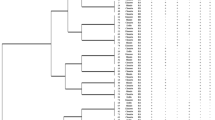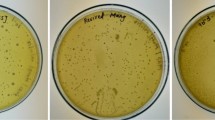Abstract
One bacterial strain U8 having starch hydrolysing activity was isolated from the rhizospheric soil of rice fields of Purba Bardhaman district in West Bengal, India. This bacterial sample was screened on nutrient agar plates (NA) and checked for starch hydrolysing activity in starch agar media. Colonies of this bacterial isolate were white and opaque with rough margins. Various tests were performed on this isolate including catalase, methyl red test, voges–proskauer, indole, citrate utilization and nitrate reduction test. Positive results were obtained for the former two tests and negative results for the latter tests. The presence of exoenzymes like gelatinase, amylase, oxidase and lipase was observed in the isolate; however, no urease was found. 16S rRNA sequencing and phylogenetic tree analyses indicated the present bacterial strain U8, was Bacillus flexus. Sugar fermentation tests revealed that Bacillus flexus U8 utilized fructose, xylose, lactose, cellobiose, dextrose and mannose as carbon sources. Antibiotic susceptibility tests showed that Bacillus flexus U8 was resistant to penicillin (10 µg/disc) and ampicillin (10 µg/disc). No haemolysis was observed on the blood agar media containing the bacterial isolate, indicating its non-pathogenic nature. The GC content of the isolate was 55% and AT content was 45%. Restriction mapping of the Bacillus flexus U8 16S rRNA gene sequence was also performed. Due to the abundance of Bacillus flexus U8 in the soil, its starch hydrolysing properties can be explored on agricultural land to potentially improve the health of the soil and plants.






Similar content being viewed by others
References
Dida G (2018) Isolation and characterization of starch degrading rhizobacteria from soil of Jimma University Main Campus. Ethiopia. Afr J Microbiol Res. 12(32):788–795
Mukesh K, Andal P, Suresh K, Saranya G, Rajendran K, Kalaichelvan P (2012) Production, purification and characterization of α-amylase and alkaline protease by Bacillus sp. HPE. 10:376–382
Tambekar DH, Tambekar SD, Jadhav AS, Kharat PA (2017) Alkaliphilic bacillus flexus: a potential source of lipase producer for industrial and medical application. Indian J Pharm Sci Res. 8(10):4313–4317
Trivedi N, Gupta V, Kumar M, Kumari P, Reddy CRK, Jha B (2011) An alkali-halotolerant cellulase from Bacillus flexus isolated from green seaweed Ulva lactuca. Carbohydr Polym 83(2):891–897
Niyonzima FN, More SS (2014) Concomitant production of detergent compatible enzymes by Bacillus flexus XJU-1. Braz J Microbiol. 45(3):903–910
Tambekar DH, Tambekar SD, Mohod NA (2015) Production and dynamics of amylase from bacillus flexus. Indian J Pharm Sci Res 5(3):195–198
Smits JP, Rinzema A, Tramper J, Van Sonsbeek HM, Knol W (1996) Solid-state fermentation of wheat bran by Trichoderma reesei QM9414: substrate composition changes, C balance, enzyme production, growth and kinetics. Appl Microbiol Biotechnol 46(5–6):489–496
Mukhtar H (2012) Concomitant production of two proteases and alpha-amylase by a novel strain of Bacillus subtilis in a microprocessor-controlled bioreactor. Braz J Microbiol. 43(3):1072–1079
Holt JG, Krieg NR, Sneath PHA, Staley JT, Williams ST (1994) Bergey’s manual of determinative bacteriology, 9th edn. Williams and Wilkins, Maryland, pp 565–596. http://hdl.handle.net/123456789/121739
Sneath PHA, Holt JG (2001) Bergey’s manual of systematic bacteriology (2nd ed) Williams and Wilkins, Springer-Verlag, vol 1, pp 64
Nusrat A, Rahman SR (2007) Comparative studies on the production of extracellular α-amylase by three mesophilic Bacillus isolates. Bangladesh J. of Microbiol. 24(2):129–132
Czaban J, Gajda A, Wróblewska B (2007) The motility of bacteria from rhizosphere and different zones of winter wheat roots. Pol J Environ Stud. 16(2):301
Smibert RM, Krieg NR (1994) Phenotype characterization. In: Gerhardt P, Murray RGE, Wood WA, Krieg NR (eds) Methods of general and molecular bacteriology. American Society for Microbiology, Washington DC, pp p607–p654
Logan NA, Berge O, Bishop AH, Busse HJ, De Vos P, Fritze D, Heyndrickx M, Kämpfer P, Rabinovitch L, Salkinoja-Salonen MS, Seldin L (2009) Proposed minimal standards for describing new taxa of aerobic, endospore-forming bacteria. Int J Syst Evol Microbiol 59(8):2114–2121
Azmi SA, Chatterjee SN, Saha NC (2014) Phenotypic and molecular characterization of bubble eye gold fish pathogenic ampicillin resistant Bacillus sp. (GF1). Int J Pharma Biol Sci 5(4):342–351
Benson DA, Karsch-Mizrachi I, Clark K, Lipman D, Ostell J, Sayers E (2012) GenBank. Nucleic Acids Res 40:D48–D53
Brown AE (2005) Benson’s microbiological applications: laboratory manual in general microbiology. McGraw-Hill Higher Education
Jansen JF, Meijer EW (1994) Encapsulation of guest molecules into a dendritic box. Science 266(5188):1226–1229
Jukes TH, Cantor CR (1969) Evolution of protein molecules. In: Munro HN (ed) Mammalian protein metabolism. Academic Press, New York
Tamura K, Dudley J, Nei M, Kumar S (2007) MEGA4: molecular evolutionary genetics analysis (MEGA) software version 4.0. Mol Biol Evol 24(8):1596–1599
Maji P, Chakrabarti C, Chatterjee S (2012) Phenotyping and molecular characterization of Lysinibacillus sp. P-011 (GU288531) and their role in the development of Drosophila melanogaster. Afr J Biotechnol 11(93):15967–15974
Pal KC, Mondal NK, Chatterjee S, Ghosh TS, Datta JK (2014) Characterization of fluoride-tolerant halophilic Bacillus flexus NM25 (HQ875778) isolated from fluoride-affected soil in Birbhum District, West Bengal. India. Environ Monit Assess. 186(2):699–709
Susilowati DN, Sudiana IM, Mubarik NR, Suwanto A (2015) Species and functional diversity of rhizobacteria of rice plant in the coastal soils of Indonesia. Indones j agric sci 16(1):39–50
Alariya SS, Sethi S, Gupta S, Lal GB (2013) Amylase activity of a starch degrading bacteria isolated from soil. Arch Appl Sci Res 5(1):15–24
Zheng Y, Wang Z, Chen X (2000) α-Amylase production by Bacillus subtilis with dregs in an external-loop airlift bioreactor. Biochem Eng J 5(2):115–121
Ha YM, Lee DG, Yoon JH, Park YH, Kim YJ (2001) Rapid and simple purification of a novel extracellular β-amylase from Bacillus sp. Biotechnol Lett 23(17):1435–1438
Kaur A, Kaur M, Samyal ML, Ahmed Z (2012) Isolation, characterization and identification of bacterial strain producing amylase. J Microbiol Biotechnol Res 2(4):573–579
Ashwini K, Gaurav K, Karthik L, Bhaskara Rao KV (2011) Optimization, production and partial purification of extracellular α-amylase from Bacillus sp. marini. Arch Appl Sci Res 3(1):33–42
Acknowledgements
The authors are thankful to the UGC, DST PURSE for providing instrumentation facilities. They are very much thankful to the Head of Department of Zoology for providing the necessary facilities to carry out the research experiments. They are also thankful to the Director of Zoological Survey of India, Kolkata, for the cooperation. They are very much thankful to Ms. Tonuka Chatterjee, Alumni of McMaster University, Canada, for scientific language editing of the manuscript.
Author information
Authors and Affiliations
Corresponding author
Ethics declarations
Conflict of interest
The authors declared that they have no conflict of interest to publish this manuscript.
Additional information
Publisher's Note
Springer Nature remains neutral with regard to jurisdictional claims in published maps and institutional affiliations.
Significance Statement Starch is one of the fundamental sources of energy and also serves as a basic material for a number of industries. The present work reveals a new bacterial strain Bacillus flexus U8 from the rice field of Purba Bardhaman district for its starch hydrolysing activity. The detailed biochemical and molecular characterization have been done. This bacterium can be used for the betterment of plant health, and also for improving the soil fertility.
Rights and permissions
About this article
Cite this article
Roy, P., Chatterjee, S., Saha, N.C. et al. Characterization of a Starch Hydrolysing Bacillus flexus U8 Isolated from Rhizospheric Soil of the Paddy Plants. Proc. Natl. Acad. Sci., India, Sect. B Biol. Sci. 90, 1075–1081 (2020). https://doi.org/10.1007/s40011-020-01176-0
Received:
Revised:
Accepted:
Published:
Issue Date:
DOI: https://doi.org/10.1007/s40011-020-01176-0




